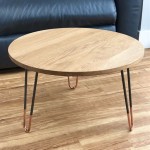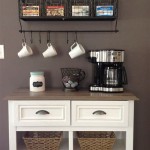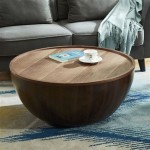Round Coffee Table Makeover Ideas
A round coffee table serves as a focal point in many living rooms, providing a surface for drinks, books, and decorative items. Over time, the table may show signs of wear and tear or simply no longer align with the evolving aesthetic of the space. Instead of replacing the table entirely, a makeover offers a cost-effective and creative solution to breathe new life into this essential piece of furniture. This article will explore various round coffee table makeover ideas, ranging from simple refinishing techniques to more elaborate decorative approaches. By employing these strategies, individuals can transform a tired coffee table into a stylish and functional addition to their home.
Refinishing and Staining Techniques
Refinishing a round coffee table is a classic method for updating its appearance. The process typically begins with sanding the existing finish to create a smooth surface for the new finish to adhere to. The level of sanding required depends on the condition of the existing finish; heavily damaged surfaces may need more aggressive sanding with coarser grit sandpaper, while lightly worn surfaces may only require a light sanding to scuff the surface. Safety precautions, such as wearing a dust mask and working in a well-ventilated area, are essential during the sanding process.
After sanding, the table should be thoroughly cleaned to remove any residual dust and debris. A tack cloth is often used for this purpose, ensuring a clean surface for the application of the new stain or paint. The choice of stain or paint will depend on the desired aesthetic. Stains are ideal for highlighting the natural grain of the wood, while paint offers a broader range of color options and can be used to create a more opaque finish. Several thin coats of stain or paint are generally preferred over one thick coat, allowing for better adhesion and a more even finish. Each coat should be allowed to dry completely before applying the next, following the manufacturer's instructions.
Once the stain or paint has dried, a protective topcoat is typically applied to enhance durability and protect the finish from scratches and spills. Polyurethane finishes are a popular choice for coffee tables due to their resistance to water and abrasion. Application methods for topcoats can vary, with options including brushing, spraying, and wiping. As with the stain or paint, multiple thin coats of topcoat are recommended for optimal protection and a smooth, even surface. The entire process of refinishing requires patience and attention to detail, but the results can significantly transform the appearance of a round coffee table.
Decorative Enhancements and Surface Treatments
Beyond refinishing, there are numerous decorative techniques that can be employed to transform a round coffee table. These techniques can add texture, pattern, and visual interest, creating a unique and personalized piece of furniture. One popular option is to apply decorative paint techniques, such as distressing, antiquing, or stenciling. Distressing involves intentionally creating imperfections in the finish to give the table a weathered and vintage look. Antiquing typically involves applying a dark glaze or stain to highlight details and create a sense of age. Stenciling allows for the creation of intricate patterns and designs on the table's surface.
Another approach is to incorporate tile or mosaic elements into the coffee table's design. This can involve creating a tiled surface on the tabletop or adding mosaic accents around the edges. Tile and mosaic surfaces are not only visually appealing but also durable and easy to clean. The choice of tile or mosaic materials can vary widely, from ceramic and glass tiles to natural stone and pebbles. Proper adhesion and grouting techniques are essential for ensuring a long-lasting and aesthetically pleasing result.
Fabric or wallpaper can also be used to decorate a round coffee table. Fabric can be applied to the tabletop using adhesive, creating a soft and textured surface. This can be a particularly effective way to add color and pattern to the table. Wallpaper can be used in a similar manner, offering a wide range of designs and textures to choose from. When using fabric or wallpaper, it is important to seal the surface with a protective topcoat to prevent staining and damage.
Another surface treatment involves using resin. Epoxy resin can be poured over the table top to create a glossy, durable surface. It can be clear, allowing the existing wood grain to show through, or tinted with pigments and dyes to create a colorful and unique design. Items such as photographs, dried flowers, and small objects can be embedded in the resin, creating a customized and visually appealing surface. This technique requires precision and care to avoid bubbles and ensure an even finish. The resin's curing time must be carefully observed.
Structural Modifications and Additions
Beyond surface treatments, more involved makeovers can include structural modifications to the round coffee table. These modifications can alter the table's height, shape, or functionality. Adding a shelf to the coffee table is a common way to increase storage space. The shelf can be attached to the existing legs or base, providing a convenient place to store books, magazines, or decorative items. The shelf can be made from wood, metal, or other materials, depending on the desired aesthetic. The method of attachment will depend on the design of the table and the materials being used, often involving screws, glue, or brackets.
Replacing the legs of the coffee table is another way to significantly alter its appearance. Different leg styles can create a variety of looks, from modern and minimalist to rustic and traditional. Tapered legs can lend a mid-century modern feel, while turned legs can evoke a more traditional aesthetic. Metal hairpin legs are a popular choice for adding a contemporary touch. The legs can be attached using screws, bolts, or metal plates, ensuring a secure and stable connection.
Adding casters to the bottom of the coffee table can enhance its mobility, making it easier to move the table around the room as needed. Casters are particularly useful for larger or heavier coffee tables. The casters can be attached using screws or bolts, and it is important to choose casters that are appropriate for the weight of the table. The selected casters should match the overall style and finish of the coffee table to maintain a cohesive look.
Transforming the table into an ottoman is another significant structural change. This involves adding padding and upholstery to the top of the table, creating a comfortable footrest or additional seating surface. The padding can be made from foam or batting, and the upholstery can be chosen to complement the surrounding décor. This type of makeover requires basic upholstery skills and tools, such as a staple gun and fabric scissors. The table frame must be sturdy enough to support the added weight and use.
By combining these refinishing, decorative, and structural techniques, individuals can transform a round coffee table into a personalized and functional piece of furniture. The possibilities are limited only by imagination and creativity. Careful planning and execution are essential for achieving a successful and long-lasting result.

How To Style A Round Coffee Table Decor Fix

Diy Round Farmhouse Coffee Table Life On Kaydeross Creek

The Basics Of Coffee Table Styling Shades Blue Interiors

Coastal Style Coffee Table Makeover With Stain And Paint Artsy Rule

How To Style A Round Coffee Table Decor Fix

Diy Round Fluted Coffee Table Step By Guide

Coffee Table Decorating Ideas

Quick Coffee Table Makeover

28 Diy Coffee Table Makeover Ideas You Can Do This Weekend Life On Kaydeross Creek

The Basics Of Coffee Table Styling Shades Blue Interiors
Related Posts








